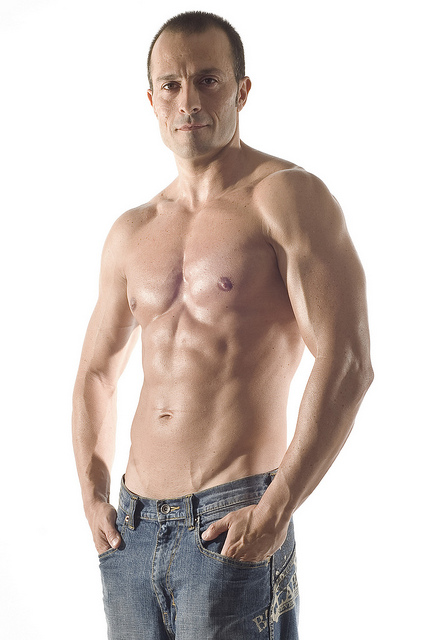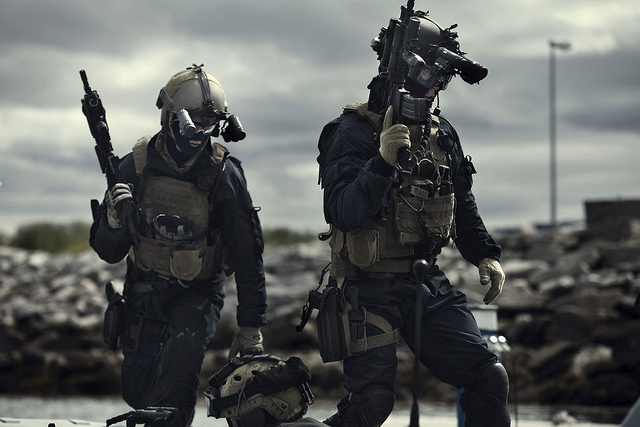I’ve talked to a lot of dudes over my career as a fitness professional, and it seems like the overwhelming majority of them want well-rounded fitness. They don’t necessarily want to be the biggest, strongest, Olympic-level, super-athletes, but they do want to be pretty good at all of the important stuff. They want to be lean, strong, resilient, and capable.
 Let me explain with a few examples…
Let me explain with a few examples…
Most men don’t want to look like a pro bodybuilder or lift like a powerlifter, but they do want to be strong and have a little bit of muscle to show for it.
Most men couldn’t care less about ranking well in the Boston marathon, but they’d like to be able to run a decent distance without getting winded or climb a mountain without needing an EMT as their trail guide.
Most men don’t want to compete with the likes of Usain Bolt, but they do want to be able to sprint without pulling a hamstring.
Most men don’t want to devote their life to yoga, but they do want to be flexible, pain-free, and able to move well.
Most men don’t care about having six pack abs, but they would like to be lean and lose their extra belly fat.
And yes, they’d like to be able to bust some cool moves that’ll impress the ladies…or at least make their wife roll her eyes, suppressing a smile.
In other words, they want to be fitness generalists. They want balanced fitness. So, how do we get it?
Well, if you go to a weightlifting club/school/coach/etc., they’ll probably tell you that you need to focus on strength training, and do some cardio and stretching, too, to balance things out. And if you go to an endurance specialist, they’ll probably tell you to try a varied sport like track and field or triathlon, and make sure you do some cross training, too. Or, if you go to a typical gym or health club, they’ll probably tell you to hire a personal trainer for a custom training plan or join a boot camp class.
And while each of these can be good options, you won’t develop true well-rounded fitness by specializing exclusively in any one discipline (e.g. weightlifting, running, martial arts, etc.). Now, you can certainly still get very fit doing any of those things, and each of them can be a worthy lifelong pursuit. But it takes a broader approach to develop well-rounded fitness, and it usually involves a variety of disciplines and modalities.
So, who has the most personal experience with well-rounded fitness anyway?
These guys do…

Yes, warriors. And to a lesser extent, our military, in general. But I’m not talking about your average soldier who can barely pass their fitness tests. I’m talking about the guys at the tip of the spear, for whom fitness is a life and death issue: special forces (e.g. SEALs, Delta Force, Rangers, etc.). These warriors have to be fit for a lot of different things, and most of the ones I’ve known have embodied well-rounded, balanced fitness – and usually, at a high level.
Here’s a glimpse into what these guys need…
- Warriors need strength to lift heavy things and carry all of their gear.
- Warriors need endurance to ruck in and out of hostile areas, for days on end.
- Warriors need speed to run or sprint to safety.
- Warriors need to move well to save energy and prevent over-use injuries.
- Warriors need power and agility to move quickly and efficiently over rough terrain.
- Warriors need mobility, flexibility, and resilience to last for the long haul.
And that’s just scratching the surface!
As one friend of mine who is a Navy SEAL, put it…
Be more like a Chevy Silverado, and not like a Corvette. So the Corvette has a lot of speed for a very short amount of time and then it peters out. And a Chevy Silverado has a lot of power and speed if you really need it, and it may not be as quick as the Corvette, but you can put a lot of weight on it, and it’s still just gonna charge hard. And that’s the kind of mentality. You don’t need to be the absolute fastest runner in the group, and the fastest swimmer, and do the most pushups, but you have to be towards the front of the pack and be competent in all things.
So, that’s great and all…for Navy SEALs. But what if you’re not a warrior? What if you don’t need to fight the bad guys or ruck for miles and miles, day after day, over harsh terrain? Well, you study what these guys do, and then use the underlying principles and methods to achieve your own goals. You adapt their strategies to meet your needs.
Absorb what is useful, reject what is useless, and add what is uniquely your own. – Bruce Lee
5 Lessons We Can Learn From Warriors About How To Develop Well-Rounded Fitness

So, how do warriors become competent in all the key aspects of fitness? Here are some of their strategies…
1. Warriors treat their health and fitness like it’s their job – They do what works, and what’s always worked. So, they don’t hop from the latest popular diet or workout program to the next. They find a good plan that has been proven to work and they follow it. They pay attention to the details. They measure and track their progress, and they test themselves regularly. They’re professionals, and they treat their health, fitness, and training in much the same way as the rest of their vocation. They make time for it, give it their full, undivided attention, and they give it everything they’ve got. It’s something they take very seriously.
2. Warriors do a few things really well and they focus on the most important tasks for their success – These guys are great about identifying their objective, coming up with a mission, executing their plan, and always ending with a debrief so that they can do better next time. They also implement enough variety in their training routine to develop broad fitness without falling into the trap of training randomly. In other words, they train with specificity in a lot of different areas (see below for an example).
3. Warriors work on their weaknesses while maintaining or slowly building their strengths – This means that they balance their strength training (e.g. calisthenics and weight lifting), with cardio (running, rucking, or swimming), and mobility/flexibility/movement supplementary work, among other things. They make time for the important stuff that most recreational trainees usually skip.
4. Warriors focus on the basics for long enough to get great results because they’re committed to the long term – They train regardless of how they feel, what the weather is like, or what day of the week it is. They do the boring, necessary work, day after day. They are the epitome of the tortoise, not the hare. And that’s why they’re able to achieve extraordinary levels of fitness and maintain it.
5. Warriors understand that they are always training – Even when they’re not exercising. This is a way of life for them, and that is why they succeed.
So, how do we put this together into a weekly schedule? Well, here’s a start…
Firstly, the Naval Special Warfare Physical Training Guide (source), which is a resource used by SEAL candidates to prepare for BUD/S training, instructs that workouts should be:
- Planned and organized
- Gradual, steady and continual
- Consistent
- Specific
- Balanced
It also provides the following general framework for a weekly workout schedule…
Weekly Workout Summary:
- 1 Long Slow Distance workout for both running and swimming
- 1 Continuous High Intensity workout for both running and swimming
- 1 Interval workout for both running and swimming
- 4-5 Calisthenics Routines
- 4-6 Strength Training Sessions – 2-3 each for upper and lower body
- 4-5 Core Exercise Routines
- Daily Flexibility Routines
- Specific injury prevention exercises as needed
Obviously, that’s a lot of work, and more than the average Joe has time for on a weekly basis. And that’s okay. You don’t need to train as much as a Navy SEAL to achieve well-rounded, extraordinary fitness. But if you read between the lines, you’ll see that warriors make sure that they do all of the important stuff to build the body’s they need for their vocation. And if you want well-rounded fitness, you’re going to have to do the same for your goals.
Final Words
If you’d like to build a lean, strong, resilient, and capable body, study how our most elite soldiers train. They know what they’re doing.
And like you, these aren’t highly-paid athletes whose entire lives are designed to optimize their performance. They have difficult jobs to do, long days, sleepless nights, and less-than-ideal diets, among other things (kindof like being a Dad!). And yet, they still manage to make it work, and I’m confident that you can, too.
If you found this article helpful, please share it with your friends:
.jpg)
![]()
Health-First Fitness Coach
P.S. If you liked this post, then please signup for the newsletter, or follow me on Facebook or Twitter for daily updates and other interesting info.
Very inspiring article,John. Did Army Reserve back in the 80s,,I am well aware our Tier One Groups such as the Seals and Green Berets are dedicated to fitness.Thanks,D
Thanks, Darryl! (for the kind words and your service)
This is my favorite fitness article on the whole internet! Exactly what I’m going for, so it motivates me. I’ve read it like 4-5 times.
Awesome article. I am a 55 year old male who has many knee surgeries including a knee replacement. I still maintain a high level of fitness by finding different ways to train. I have developed my own integrated system that includes; strength, flexibility, cardio, and balance every week. I have to admit after my knee replacement, I was concerned I would not be able to maintain my level of fitness. However, I found new low-impacting activities which include rucking, mountain biking, and Incline walking on a treadmill. I found the key to maintaining a fitness program (similar to your article) NEVER focus on what you cannot do, but always focus on what you CAN DO..